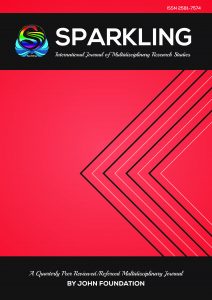Sparkling International Journal of Multidisciplinary Research Studies
(A Quarterly Peer Reviewed/Refereed Multidisciplinary Journal)

PUBLICATION ETHICS AND MALPRACTICE STATEMENT
Sparkling International Journal of Multidisciplinary Research Studies and its Publisher (John Foundation), Authors, Reviewers and Editors all have to follow the best practices on Ethical Academic Publishing.
Duties of Editors
The Editor should shoulder the responsibility for the content of the Journal and take responsibility for navigating the technical direction of the Journal. The editor-in-chief ultimately decides whether a submitted manuscript can be published or not after seeking input from reviewers.
Key Responsibilities
- The editor-in-chief has to ensure that all contributions are of good quality, relevant and in good English; are original, and do not infringe copyright, do not contain any scandalous, obscene, and unlawful or otherwise objectionable material.
- He has to take responsibility for the approved content of the journal and maintain the standard of the journal.
- The editor-in-chief has to ensure that each issue is released on time.
- The editor-in-chief has to check plagiarism. He has to receive the plagiarism report of the content from the respective authors of the article or research paper.
- The editor-in-chief should cross-check all citations and examine all the references provided in the document.
- The editor-in-chief upholds the ethics and policies of the John Foundation in publishing the Journal. Ethical violations may involve, but are not limited to, copyright violations, republishing, plagiarising (including self-plagiarising), falsification of data or results, misattribution of authors, or misattribution of citations.
- He/She examines the nature and scope of the Journal, features, time to decision, enhancements to the electronic versions, and the Journal website.
- Meticulously observes the editorial aspects and standard of the publication under a peer review process in order to publish high-quality articles. He examines the comments of the referees and in light of the referees’ recommendations, on whether to publish or not.
- The editor-in-chief is responsible for appeals of manuscripts being released from the Journal.
Duties of Reviewers
The reviewers, after accepting the invitation, will have access to the complete manuscript and should immediately
- See whether the article has a conflict of interest or self-biased, or partial.
- Check whether the manuscript is fitting and fulfilling the scope of the journal.
The authors may be given proper instructions by the reviewers if they come across any problems with regard to the interest of the article. If the review reveals that the manuscript does not fit within the scope of the journal, they indicate that in the review form.
The manuscript provided for review is a privileged document. It has to be protected from any form of exploitation.
The Procedure of Reviewing
The reviewers have to go through manuscripts very meticulously and judge effectively based on the following aspects
✔ Originality
✔ The topic of the subject matter and its suitable title.
✔ Techniques, Methods, Approaches relevant to the topic selected.
✔ Data analysed using appropriate statistical techniques.
✔ Literature citations are both in the documents and the reference.
✔ Selection of scientific formats such as APA, MLA and so on.
✔ Proper interpretation and discussion of the findings.
✔ The capability of organising ideas and coherence.
✔ Adherence to the instructions to authors.
✔ Appropriateness of figures and tables found in the manuscript.
✔ Prescribed length.
Key points to be noted by the reviewers
Plagiarism – Plagiarism can involve any part of the manuscript, including figures and tables, in which material is copied from another publication without attestation, reference or permission.
Reviewers may give criticisms, arguments, and suggestions concerning the paper to the editor and to the author if they are carefully documented. Reviewers are expected to substantiate the statements and suggest acceptability as noted on the specific review form.
In comments intended for the author, they should organise the review so that an abstract summarises the major findings of the article, gives the overall impression of the paper, and highlights the major shortcomings.
The reviewer advises the editor of their recommendation for acceptance, modification, or rejection of the manuscript after a thorough evaluation.
Duties of Authors
Authors have to submit their manuscripts electronically via email to the Corresponding Editor. Each manuscript is reviewed by internal reviewers for relevancy to the journal.
Authors should reflect their own novel ideas, thoughts and scientific knowledge by presenting their papers.
Authors should be careful in giving citations that match with references. References should be very strictly followed as instructed/directed using APA/MLA format.
Only persons who were involved in the intellectual contribution to the manuscript should be listed as authors. They must be able to take public responsibility for the content.
Authors must reveal all sources of financial support for the work if they received it from any funding agencies.
Authors should actively participate in the peer review process and cooperate fully by responding promptly to editors’ requests for data, clarifications, proof of ethics and copyright permissions.
Authors may be permitted to correct the time for their paper as per the instructions/suggestions given by the reviewers.
Duties of the Publisher
In cases of fraudulent publication or plagiarism, the publisher, in close collaboration with the Editor-in-Chief, will take all appropriate measures to clarify the situation and to amend the article in question.
The Publisher and the Journal do not discriminate on the basis of age, colour, religion, creed, disability, national origin, race, gender, career status in its publishing programmes, services and activities.
Access to Journal Content
The publisher has to take sole authority over the permanent in publishing scholarly articles and ensure that they are served as the database in their own digital archive in their journal website.
